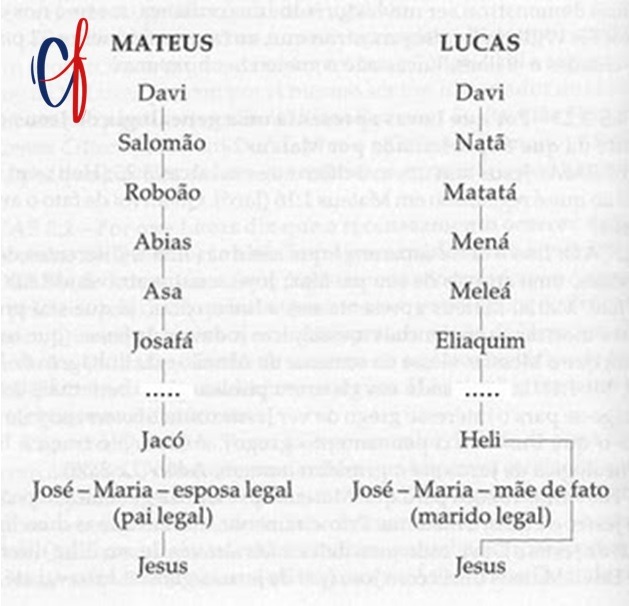The Genealogies of Jesus
THE GENEALOGIES OF JESUS

There are two records in the Gospels of Matthew and Lucas that relate the genealogies of Jesus (Matthew 1 and Luke 3:23-38). These accounts are substantially different. The genealogy given by Luke is traced through Maria (Jesus's carnal mother – highlighting His humanity) and Matthew's did so through Joseph (Jesus' legal father – highlighting His royal descent from King David).
These genealogies were narrated with the aim of showing and highlighting the birth of a child with royal lineage, in Matthew, and Luke addresses the genealogy of Jesus continually going back to Adam, with the aim of showing Jesus as a man.
Matthew briefly mentions a total of 46 ancestors who would have lived up to about two thousand years beforeJesus, starting withAbraham. In his account, the apostle cites not only heroes of faith, but also mentions the names of foreign women who were part of the genealogy of both Jesus and David, which in this case were Ruth, Rahab and Tamar. Nor does it omit the names of wicked men like Manasseh and Abijah, or of people who did not achieve prominence in Scriptures. He then divides Jesus' genealogy into three groups of fourteen generations: from Abraham to David, from David to Babylonian captivity, occurred in 586 B.C., and from the Jewish exile to Jesus.
The purpose of Matthew’s Gospel is to demonstrate beyond doubt to the Jews that Jesus is the Messiah, the true King, promised by God. Thus, the only place in the Bible where the term “kingdom of heaven” appears thirty-three times is in the book of Matthew. Matthew proves that Jesus was born of royal lineage. At his birth he receives gifts worthy of royalty (Matthew 2:11). In Matthew 3 he is described as the forerunner of the King, proclaiming that the Kingdom is at hand. The Sermon on the Mount is truly the manifesto of this King. His miracles are his credentials (Matthew 8 and 9). His parables are called “parables of the Kingdom.” Even outside the country he was called “the Son of David.” Finally he entered Jerusalem as King; he foretold his return in glory to reign. At his death the rocks split, the earth shook, and the dead came out of their graves. His resurrection was with majestic power, marked by an earthquake and great terror among the guards. In His last words He proclaimed His right as King and gave His royal command: “All power is given unto me in heaven and in earth. Go ye therefore...” (Matthew 28:18,19).
Luke, surpassing Matthew, provides a greater number of Jesus' ancestors. This genealogy is considered by some scholars to be the genealogy of Mary, and thus the maternal genealogy of Jesus, which would explain part of the differences between this and the genealogy presented by Matthew.
Luke was a physician (Colossians 4:14), and no one better than a physician can describe Jesus from the perspective of his humanity, that is, Jesus as a man. Only Luke describes human details, for example: the birth and adolescence of Jesus Christ and His precursor (John the Baptist); relevant historical facts about His time here on earth; details of His pain in the moments leading up to His sacrifice on the cross of Calvary, such as the symptoms of hematidrosis (sweating blood).
The Gospel of Luke was written for the Gentiles, to show that Jesus is the example to be followed, even though He was God, He became man, cried, suffered and lived in His own way due to the limitations of man. Thus, He knows our pain, He Himself suffered all our afflictions so that today we might find hope (Hebrews 4:14-16).
Thus, in the genealogy described in Luke 3:23-38, Jesus (as was believed) was the son of Joseph, and Joseph was the son of Heli (who was Joseph's father-in-law, according to historical tradition). At that time, women were not considered in genealogies. And so Luke describes the human genealogy of Jesus, for He was, in fact, the carnal and biological son of Mary, associating Him with our human nature and race.
THE GOSPEL OF MARK: ABSENCE OF GENEALOGY?
The book of Mark was written for the Romans to show Jesus as an example of a servant (worker). Mark repeatedly uses the words “immediately” and “immediately” in his narrative, describing continuous action and tireless execution and fulfillment of obedience to God’s plan. Without delay or hesitation, the faithful servant fulfills the work entrusted to him, moving quickly from one action to another among the needy and suffering people. Therefore, there are no genealogical records, because servants do not need genealogies, since He is there to obey and fulfill the will of His Lord. The Roman audience, to whom Mark directed his gospel, was not interested in knowing where a servant had come from, but rather in knowing what he could do.
THE GOSPEL OF JOHN: DIVINE GENEALOGY
The Gospel of John was written as a universal book to show that Jesus is the Son of God (His divinity). Thus, at the beginning of the book, it describes the genealogy of Jesus as being the Son of the Creator, to emphasize (among other passages in the book) in an even more vivid and intimate way the love, majesty and power of His Father.
Thus, in John 1:1-3 it states that “In the beginning was the Word, and the Word was with God, and the Word was God. 2 The same was in the beginning with God. 3 All things were made by him; and without him was not any thing made that was made.” And further on in John 1:14, “And the Word was made flesh, and dwelt among us, (and we beheld his glory, the glory as of the only begotten of the Father,) full of grace and truth.”